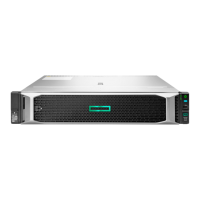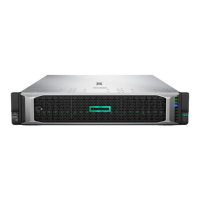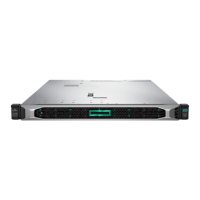Operating system considerations: Virtual Floppy/USB key
• Boot process and DOS sessions—During the boot process and DOS sessions, the virtual floppy
device appears as a standard BIOS floppy drive (drive A). If a physically attached floppy drive exists, it
is unavailable at this time. You cannot use a physical local floppy drive and a virtual floppy drive
simultaneously.
• Windows Server 2008 or later—Virtual Floppy/USB key drives appear automatically after Windows
recognizes the USB device. Use the virtual device as you would use a locally attached device.
To use a Virtual Floppy as a driver diskette during a Windows installation, disable the integrated
diskette drive in the host RBSU, which forces the virtual floppy disk to appear as drive A.
To use a virtual USB key as a driver diskette during a Windows installation, change the boot order of
the USB key drive. Hewlett Packard Enterprise recommends placing the USB key drive first in the boot
order.
• Windows Vista—Virtual Media does not work correctly on Windows Vista when you use Internet
Explorer 7 with Protected Mode enabled. If you attempt to use Virtual Media with Protected Mode
enabled, various error messages appear. To use Virtual Media, select Tools > Internet Options >
Security, clear Enable Protected Mode, and then click Apply. After you disable Protected Mode,
close all open browser instances and restart the browser.
• Red Hat Enterprise Linux and SuSE Linux Enterprise Server—Linux supports the use of USB
diskette and key drives.
Changing diskettes
When you are using a Virtual Floppy/USB key on a client machine with a physical USB disk drive, disk-
change operations are not recognized. For example, if a directory listing is obtained from a floppy disk,
and then the disk is changed, a subsequent directory listing shows the directory listing for the first disk. If
disk changes are necessary when you are using a Virtual Floppy/USB key, make sure that the client
machine contains a non-USB disk drive.
Operating system considerations: Virtual CD/DVD-ROM
MS-DOS
The Virtual CD/DVD-ROM is not supported in MS-DOS.
Windows
The Virtual CD/DVD-ROM appears automatically after Windows recognizes the mounting of the
device. Use it as you would use a locally attached CD/DVD-ROM device.
Linux
The requirements for Red Hat Enterprise Linux and SuSE Linux Enterprise Server follow:
• Red Hat Enterprise Linux—On servers that have a locally attached CD/DVD-ROM, the Virtual
CD/DVD-ROM device is accessible at /dev/cdrom1. However, on servers that do not have a
locally attached CD/DVD-ROM, such as BL c-Class blade systems, the Virtual CD/DVD-ROM is
the first CD/DVD-ROM accessible at /dev/cdrom.
132 Operating system considerations: Virtual Floppy/USB key
